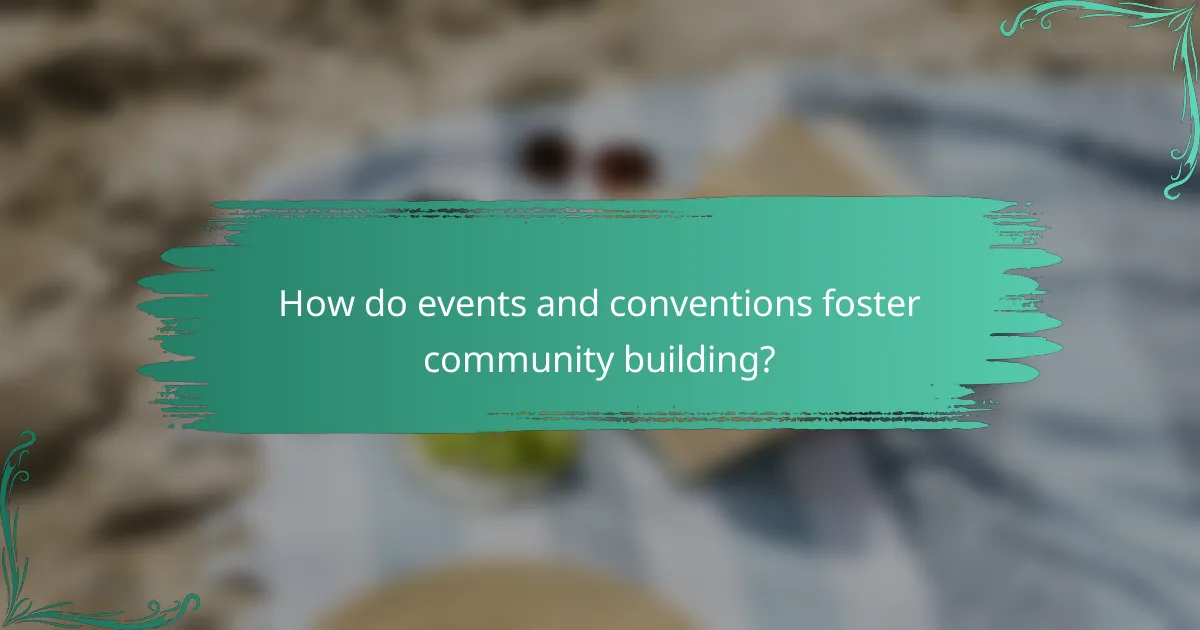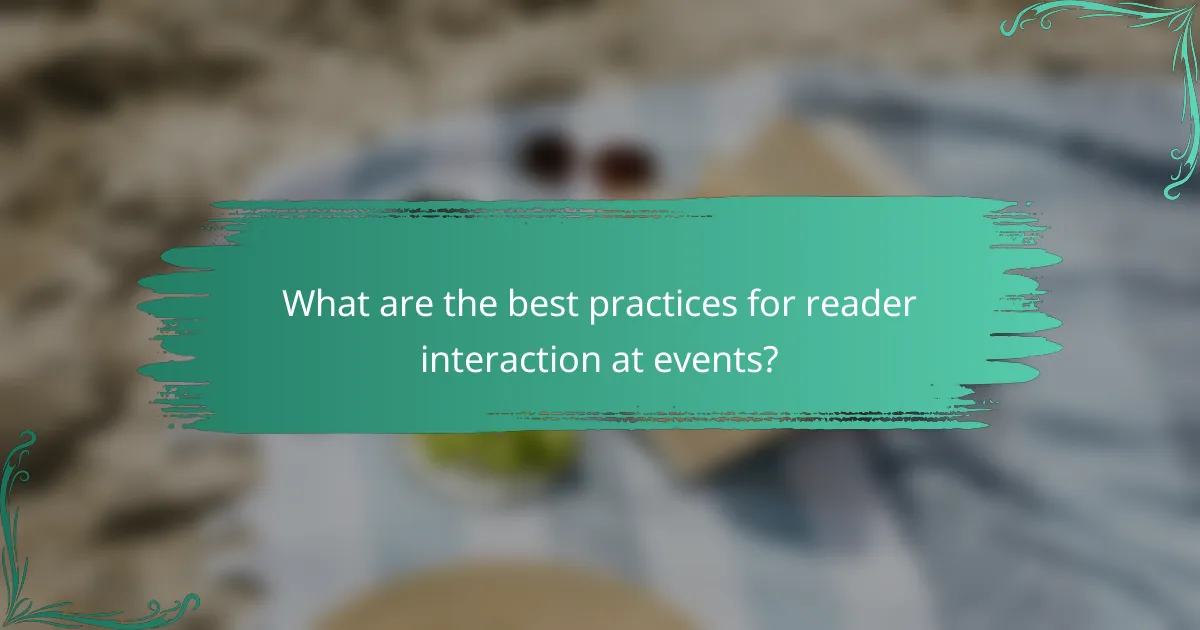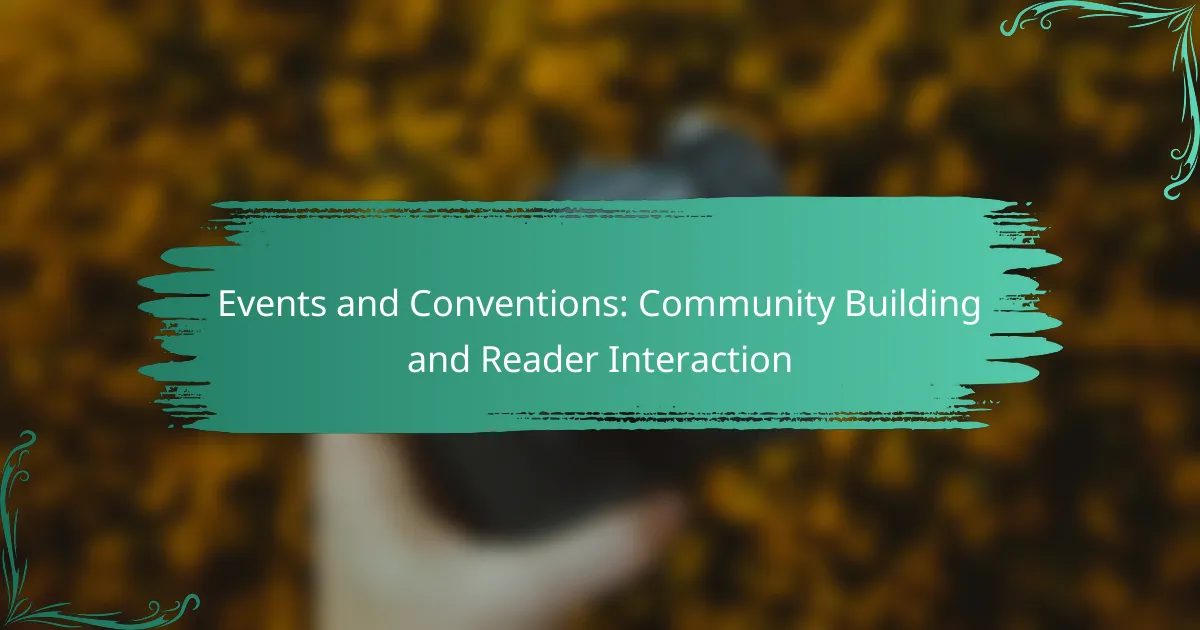Events and conventions are essential for community building, as they unite individuals with common interests and foster connections that create a sense of belonging. By incorporating interactive sessions and feedback mechanisms, these gatherings enhance reader interaction, allowing for meaningful communication and collaboration. Various formats, such as conferences and workshops, cater to diverse audiences, promoting knowledge sharing and relationship building among participants.

How do events and conventions foster community building?
Events and conventions play a crucial role in fostering community building by bringing together individuals with shared interests, facilitating connections, and creating a sense of belonging. These gatherings provide a platform for interaction, learning, and collaboration, which strengthens community ties.
Networking opportunities
Networking opportunities at events and conventions allow attendees to meet like-minded individuals, industry professionals, and potential collaborators. Engaging in conversations and exchanging contact information can lead to lasting professional relationships and partnerships.
To maximize networking, consider attending workshops or panels that align with your interests. Participating in informal gatherings, such as meet-and-greets or social hours, can also enhance your chances of connecting with others.
Shared experiences
Shared experiences during events create lasting memories and strengthen bonds among participants. Whether it’s attending a keynote speech, participating in hands-on activities, or simply enjoying meals together, these moments foster camaraderie and a sense of community.
To enhance shared experiences, engage actively in discussions and group activities. Sharing your insights or stories can encourage others to do the same, enriching the overall experience for everyone involved.
Collaborative projects
Collaborative projects initiated at events can lead to innovative ideas and solutions. When individuals come together to work on a common goal, they leverage diverse skills and perspectives, which can enhance creativity and productivity.
To initiate collaborative projects, consider forming small groups during the event to brainstorm ideas. Follow up after the event to maintain momentum and continue working on the projects, ensuring that the connections made during the event translate into tangible outcomes.

What are the best practices for reader interaction at events?
Effective reader interaction at events involves engaging attendees through various methods that foster communication and feedback. Utilizing interactive sessions, feedback mechanisms, and social media engagement can significantly enhance the overall experience and build a stronger community.
Interactive sessions
Interactive sessions are designed to actively involve participants, encouraging them to engage with the content and each other. Formats like workshops, Q&A panels, and live demonstrations can create a dynamic environment that promotes discussion and collaboration.
Consider incorporating activities such as breakout groups or hands-on exercises to facilitate deeper connections among attendees. Aim for a balance between structured content and open dialogue to keep participants engaged and invested.
Feedback mechanisms
Implementing feedback mechanisms allows attendees to share their thoughts and experiences, which can guide future events. Options include post-event surveys, suggestion boxes, and live polling during sessions to capture real-time insights.
Ensure that feedback is easy to provide and analyze. For instance, using digital tools can streamline the process and encourage higher participation rates. Aim for a mix of quantitative ratings and qualitative comments to gather comprehensive feedback.
Social media engagement
Social media engagement is crucial for extending the conversation beyond the event. Create dedicated hashtags and encourage attendees to share their experiences, photos, and insights on platforms like Twitter, Instagram, or Facebook.
Consider hosting live social media sessions or contests to incentivize participation. Regularly monitor and respond to posts to foster a sense of community and keep the conversation going, even after the event concludes.

What types of events are most effective for community engagement?
Effective community engagement events include conferences, workshops, and webinars, each serving distinct purposes and audiences. These formats foster interaction, knowledge sharing, and relationship building among participants.
Conferences
Conferences are large gatherings that typically feature multiple speakers, panel discussions, and networking opportunities. They can attract hundreds to thousands of attendees, making them ideal for broad community engagement.
When organizing a conference, consider the theme and target audience to ensure relevant content. Provide ample networking sessions to facilitate connections among participants, as these interactions can lead to lasting relationships.
Workshops
Workshops are smaller, hands-on events focused on skill development or specific topics. They usually involve interactive activities, allowing participants to engage directly with the material and each other.
To maximize the effectiveness of a workshop, limit attendance to ensure personalized attention and interaction. Use practical examples and real-life scenarios to make the content relatable and applicable.
Webinars
Webinars are online seminars that allow for remote participation, making them accessible to a wider audience. They can include presentations, Q&A sessions, and interactive polls to engage attendees.
When hosting a webinar, ensure you have reliable technology to avoid disruptions. Promote the event through social media and email to reach potential participants, and consider recording the session for those who cannot attend live.

How can brands leverage events for advertising?
Brands can effectively leverage events for advertising by creating engaging experiences that resonate with attendees. This approach not only enhances brand visibility but also fosters deeper connections with potential customers through interactive participation.
Sponsored sessions
Sponsored sessions allow brands to host workshops, panels, or discussions at events, providing valuable content while promoting their products or services. These sessions can attract a targeted audience, enhancing brand credibility and authority in the industry.
When planning a sponsored session, consider the interests of the audience and align the content with your brand message. Engaging speakers and interactive formats can significantly increase attendance and participation.
Branded merchandise
Branded merchandise serves as a tangible reminder of your brand, creating lasting impressions on event attendees. Items such as tote bags, t-shirts, or tech gadgets can be distributed during events, effectively increasing brand exposure.
Choose practical and appealing merchandise that aligns with your brand identity. Quality items are more likely to be used and appreciated, extending your brand’s reach beyond the event itself.
Event partnerships
Forming event partnerships can amplify brand visibility and create mutually beneficial opportunities. Collaborating with event organizers or other brands can enhance your reach and provide access to new audiences.
When considering partnerships, look for brands or events that share similar values and target demographics. Joint promotions, co-hosted sessions, or shared booths can create a more impactful presence at the event.

What are the key metrics for measuring event success?
Key metrics for measuring event success include attendance rates, participant feedback, and social media reach. These metrics provide insights into how well an event met its objectives and the overall engagement of attendees.
Attendance rates
Attendance rates indicate the number of participants compared to the expected turnout. A successful event typically sees attendance rates in the range of 70-90% of registered participants. Tracking this metric helps organizers assess interest and plan future events more effectively.
To improve attendance rates, consider offering early-bird registration discounts or incentives for group sign-ups. Monitoring registration trends can also help identify potential barriers to attendance.
Participant feedback
Participant feedback is crucial for understanding attendee satisfaction and areas for improvement. Surveys conducted immediately after the event can yield valuable insights, with a focus on aspects such as content quality, speaker effectiveness, and overall experience.
Utilizing a mix of quantitative ratings (like a 1-5 scale) and qualitative comments can provide a comprehensive view of participant sentiments. Aim for a response rate of at least 30% to ensure the feedback is representative.
Social media reach
Social media reach measures the visibility and engagement of your event across platforms like Facebook, Twitter, and Instagram. Metrics to track include the number of posts, shares, likes, and comments related to the event. A higher reach often correlates with greater event awareness and interest.
To enhance social media reach, create a dedicated event hashtag and encourage attendees to share their experiences online. Collaborating with influencers or partners can also amplify your event’s visibility in the digital space.

How do virtual events compare to in-person conventions?
Virtual events offer flexibility and accessibility, while in-person conventions provide direct personal interaction and networking opportunities. Each format has distinct advantages and challenges that can impact attendee experience and engagement.
Cost-effectiveness
Virtual events generally have lower costs compared to in-person conventions. Expenses such as venue rental, travel, accommodation, and catering can add up significantly for physical gatherings, often reaching thousands of dollars.
In contrast, hosting a virtual event typically requires investment in technology and platform fees, which can range from a few hundred to a couple of thousand dollars. This makes virtual events a more budget-friendly option for many organizations.
When planning, consider the potential savings from reduced travel and accommodation costs for attendees. However, ensure that the quality of the virtual experience is maintained to keep participants engaged and satisfied.
